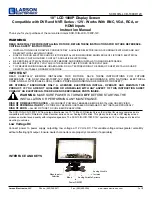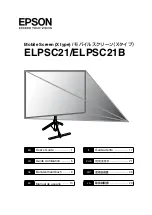
2
PRE-INSTALLATION
1. Carefully unpack screen.
2. Make sure to recheck measurements of screen location before installation.
3. Remove center support brackets (on 8' and wider screens only), reverse brackets and reinstall flush with the top of the
box.
INSTALLATION
1. Install screen by raising unit into position between joists at one end only. Install one lag screw in each mounting
bracket.
2. Level unit lengthwise with a carpenter’s level and plumb level. Secure opposite end.
CAUTION! Do not seal in until screen has been secured in position and properly tested for satisfactory operation.
3. Detach access panel by removing screws, see figure 1.
4. Remove junction box cover plate.
5. Install electrical hook up that applies to your unit. Make sure to review your electrical installation checklist and wir-
ing diagrams (included) for either 120 volt switch, 220/240 volt switch or DRC low voltage control.
NOTE: Must be installed in accordance with the requirements of the Local Building Codes, the Canadian Electrical Code (CEC),
CAN/CSA C22.1 and the National Electric Code (NEC), NFPA 70.
CAUTION! DO NOT CUT TAPE ON FABRIC WITH KNIFE OR ANY SHARP TOOL. PULL ORANGE STRING.
6. Carefully remove wood boards securing mask surface to case.
7. Carefully remove tape strips securing picture surface around roller. Slats should move freely (Fig. 2).
8. Test installation by carefully running picture and mask surfaces up and down several times. Be prepared to stop
screen. Standard Duty Cycle: 1 MIN. ON / 3 MIN. OFF.
9. Run the picture surface upward. When the picture surface is fully up the limit switch (in the motor) is tripped and
the motor shuts off.
10. Test the mask surface the same as testing the picture surface. The mask will start down off the front of the roller,
travel completely down past the bottom of the viewing surface, then “step back” against the viewing surface to
eliminate shadowing by rolling up the back side of the roller. Do not adjust the limits to change this feature.
11. Check for satisfactory condition by operating screen a few times. Reinstall access panel.
s
!
s
!
FIGURE 1
FIGURE 2
DRyWaLL SCReW
aCCeSS PaNeL
aDjuSTMeNT
kNOB
“UP”
TaPe STRIPS
MaChINe SCReW
PICTuRe SuRFaCe
SLaTS
MaSk SuRFaCe
aDjuSTMeNT
kNOB
“DOWN”
MaSk MOTOR
SCReeN MOTOR


























